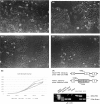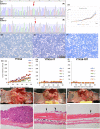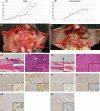Established gastric cancer cell lines transplantable into C57BL/6 mice show fibroblast growth factor receptor 4 promotion of tumor growth
- PMID: 29532565
- PMCID: PMC5980194
- DOI: 10.1111/cas.13569
Established gastric cancer cell lines transplantable into C57BL/6 mice show fibroblast growth factor receptor 4 promotion of tumor growth
Abstract
Previously no mouse gastric cancer cell lines have been available for transplantation into C57BL/6 mice. However, a gastric cancer model in immunocompetent mice would be useful for analyzing putative therapies. N-Methyl-N-nitrosourea (MNU) was given in drinking water to C57BL/6 mice and p53 heterozygous knockout mice. Only 1 tumor from a p53 knockout mouse could be cultured and the cells s.c. transplanted into a C57BL/6 mouse. We cultured this s.c. tumor, and subcloned it. mRNA expression in the most aggressive YTN16 subline was compared to the less aggressive YTN2 subline by microarray analysis, and fibroblast growth factor receptor 4 (FGFR4) in YTN16 cells was knocked out with a CRISPR/Cas9 system and inhibited by an FGFR4 selective inhibitor, BLU9931. These transplanted cell lines formed s.c. tumors in C57BL/6 mice. Four cell lines (YTN2, YTN3, YTN5, YTN16) were subcloned and established. Their in vitro growth rates were similar. However, s.c. tumor establishment rates, metastatic rates, and peritoneal dissemination rates of YTN2 and YTN3 were lower than for YTN5 and YTN16. YTN16 established 8/8 s.c. tumors, 7/8 with lung metastases, 3/8 with lymph node metastases and 5/5 with peritoneal dissemination. FGFR4 expression by YTN16 was 121-fold higher than YTN2. FGFR4-deleted YTN16 cells failed to form s.c. tumors and showed lower rates of peritoneal dissemination. BLU9931 significantly inhibited the growth of peritoneal dissemination of YTN16. These studies present the first transplantable mouse gastric cancer lines. Our results further indicate that FGFR4 is an important growth signal receptor in gastric cancer cells with high FGFR4 expression.
Keywords: C57BL/6 mouse; FGFR4; animal model; gastric cancer; immunocompetent.
© 2018 The Authors. Cancer Science published by John Wiley & Sons Australia, Ltd on behalf of Japanese Cancer Association.
Figures







Similar articles
-
Established fibrous peritoneal metastasis in an immunocompetent mouse model similar to clinical immune microenvironment of gastric cancer.BMC Cancer. 2020 Oct 20;20(1):1014. doi: 10.1186/s12885-020-07477-x. BMC Cancer. 2020. PMID: 33081727 Free PMC article.
-
Identification of Neoantigens in Two Murine Gastric Cancer Cell Lines Leading to the Neoantigen-Based Immunotherapy.Cancers (Basel). 2021 Dec 27;14(1):106. doi: 10.3390/cancers14010106. Cancers (Basel). 2021. PMID: 35008270 Free PMC article.
-
Molecular and Immune Profiling of Syngeneic Mouse Models Predict Response to Immune Checkpoint Inhibitors in Gastric Cancer.Cancer Res Treat. 2023 Jan;55(1):167-178. doi: 10.4143/crt.2022.094. Epub 2022 May 20. Cancer Res Treat. 2023. PMID: 35609622 Free PMC article.
-
Fibroblast Growth Factor Receptor 4 Targeting in Cancer: New Insights into Mechanisms and Therapeutic Strategies.Cells. 2019 Jan 9;8(1):31. doi: 10.3390/cells8010031. Cells. 2019. PMID: 30634399 Free PMC article. Review.
-
Interrupting the FGF19-FGFR4 Axis to Therapeutically Disrupt Cancer Progression.Curr Cancer Drug Targets. 2019;19(1):17-25. doi: 10.2174/1568009618666180319091731. Curr Cancer Drug Targets. 2019. PMID: 29557750 Review.
Cited by
-
Inhibition of cancer cell‑platelet adhesion as a promising therapeutic target for preventing peritoneal dissemination of gastric cancer.Oncol Lett. 2023 Nov 1;26(6):538. doi: 10.3892/ol.2023.14125. eCollection 2023 Dec. Oncol Lett. 2023. PMID: 38020309 Free PMC article.
-
Identification of metabolism-related genes for predicting peritoneal metastasis in patients with gastric cancer.BMC Genom Data. 2022 Dec 12;23(1):84. doi: 10.1186/s12863-022-01096-0. BMC Genom Data. 2022. PMID: 36503378 Free PMC article.
-
Efficacy of a Third-Generation Oncolytic Herpes Virus G47Δ in Advanced Stage Models of Human Gastric Cancer.Mol Ther Oncolytics. 2020 Apr 8;17:205-215. doi: 10.1016/j.omto.2020.03.022. eCollection 2020 Jun 26. Mol Ther Oncolytics. 2020. PMID: 32346610 Free PMC article.
-
Synthetic retinoid-mediated preconditioning of cancer-associated fibroblasts and macrophages improves cancer response to immune checkpoint blockade.Br J Cancer. 2024 Jul;131(2):372-386. doi: 10.1038/s41416-024-02734-3. Epub 2024 Jun 7. Br J Cancer. 2024. PMID: 38849479 Free PMC article.
-
Modeling human gastric cancers in immunocompetent mice.Cancer Biol Med. 2024 Jun 28;21(7):553-70. doi: 10.20892/j.issn.2095-3941.2024.0124. Cancer Biol Med. 2024. PMID: 38940675 Free PMC article. Review.
References
-
- Ferlay J, Soerjomataram I, Dikshit R, et al. Cancer incidence and mortality worldwide: sources, methods and major patterns in GLOBOCAN 2012. Int J Cancer. 2015;136:E359‐E386. - PubMed
-
- Donehower LA. The p53‐deficient mouse: a model for basic and applied cancer studies. Semin Cancer Biol. 1996;7:269‐278. - PubMed
-
- Yamamoto M, Tsukamoto T, Sakai H, et al. p53 knockout mice (‐/‐) are more susceptible than (+/‐) or (+/+) mice to N‐methyl‐N‐nitrosourea stomach carcinogenesis. Carcinogenesis. 2000;21:1891‐1897. - PubMed
MeSH terms
Substances
Grants and funding
LinkOut - more resources
Full Text Sources
Other Literature Sources
Medical
Molecular Biology Databases
Research Materials
Miscellaneous

